Snake Plant Care Guide
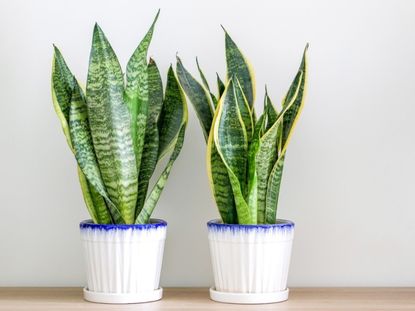

If a prize were available for the most easy to grow plant, snake plant (Sansevieria) would certainly be one of the frontrunners. Snake plant care is very straightforward. These plants can be neglected for weeks at a time, and with their strappy leaves and architectural shape, they still look fresh.
Additionally, they can survive low light levels and drought, and have few insect problems. NASA research has even shown that snake plants are able to help keep the air inside your home clean, removing toxins such as formaldehyde and benzene. In short, they are the perfect houseplants.
There are still some things you need to know to keep your snake plant looking its best, however. Read on for our expert advice on how to care for snake plants, including light, water, and soil requirements, popular varieties, and more.
Quick Facts about Snake Plants
- Botanical name - Dracaena trifasciata, Sansevieria
- Height - 2 to 4 feet (0.6 to 1.2 m)
- Spread - 1 to 2 feet (0.3to 0.6 m)
- Sun exposure - partial shade
- Soil requirements - well drained potting mix
- Hardiness zones - 10 to 12
- When to plant - year round indoors
Snake Plant Benefits
There are a few benefits to growing a snake plant in your home. It is a striking and attractive foliage plant. The most common species grown indoors in North America, it has tall, striped, and sword-shaped leaves. Grown outdoors in its native range, a snake plant can grow up to four feet (1.2 m) and produce flowers and berries. As a houseplant, it won’t grow much taller than two feet, and you will likely never see any snake plant flowers.
Snake plant care indoors as a houseplant is very easy. It’s one of the houseplants that you have to work hard to kill. These are reasons enough to get one, but as a bonus, snake plants have also been found to purify indoor air.
Snake Plant Care Guidelines
Care for snake plants is very easy and a major reason people choose it as a houseplant. Give it a sturdy container with high-quality potting mix, a spot in bright, indirect light, and occasional water, and it will thrive.
You can let it dry out between waterings and water very little in the winter. To grow outdoors year-round, snake plants require a tropical climate, but you can move a container outside to a partially shady spot in summer.
Gardening tips, videos, info and more delivered right to your inbox!
Sign up for the Gardening Know How newsletter today and receive a free download of our DIY eBook "Bring Your Garden Indoors: 13 DIY Projects For Fall And Winter".
Snake Plant Soil & Light Requirements
Any quality potting mix is a good choice for growing a snake plant in a container. Good drainage is essential, so the container should have holes in the bottom and the soil should be light. Also, be sure to choose a pot that is wide enough to be stable. As a snake plant grows taller, it can become top heavy.
A snake plant only needs a few hours of direct light per day. The rest of the day, it will do fine in shade or low, indirect light. For a snake plant outdoors in summer, provide shade during the hottest part of the day.
How Often to Water a Snake Plant
Water regularly during the growing season from spring to fall, but take care not to overwater a snake plant. It will not tolerate standing water or soggy soil, which can lead to root rot. It’s best to let the soil dry out between waterings. In winter, you can reduce watering to just once every month or two.
Fertilizer for Snake Plant
Snake plants do not require much fertilizer. You can promote growth by providing a balanced fertilizer prepared at half strength. Apply it once a month during the growing season only.
Snake Plant Propagation & Repotting
Growing snake plant from cuttings is relatively easy. The most important thing to remember is that they can easily rot, so a free draining soil needs to be used. Leaf cuttings are the usual method, but probably the easiest way to propagate snake plants is by dividing. The roots produce fleshy rhizomes, which can simply be removed with a sharp knife and potted up. Again, these will need to go into a free draining soil.
You should repot a snake plant every 3 to 5 years.
Problems Growing Snake Plants
Snake plants have very few issues when grown indoors as houseplants. The most common problem is root rot, which can lead to droopy snake plant leaves. You can avoid this by ensuring good drainage and not overwatering.
Check Out Our Complete Guide to Houseplants
Types of Snake Plant
There are around 70 different species of snake plant, all native to tropical and sub-tropical regions of Europe, Africa, and Asia. They are all evergreen and can grow anywhere from 8 inches (20 cm) to 12 feet (3.5 m) high.
The most commonly used species for gardening is Sansevieria trifasciata, often known as mother-in-law’s tongue. However, if you’d like something a little different, the following species and cultivars are worth looking out for:
- "Laurentii" -- This cultivar has attractive yellow bands at the edges of its green leaves.
- "Moonglow" -- This variety has a silvery green color and lacks the stripes of other varieties
- Sansevieria ‘Golden Hahnii’ – This species has short leaves with yellow borders.Cylindrical snake plant (Sansevieria cylindrical) – Cylindrical snake plant has round, dark green, striped leaves and can grow to 2 to 3 feet (61 to 91 cm).
- Sansevieria trifasciata "Twist" – As the name suggests, this cultivar has twisted leaves. It is also striped horizontally, has yellow variegated edges and grows to about a 14 inches (35.5 cm) tall.
- Rhino Grass (Sansevieria desertii) – This one grows to around 12 inches (30+ cm) with succulent red tinted leaves.
- White Snake Plant (Sansevieria trifasciata "Bantel’s Sensation") – This cultivar grows to around 3 feet (91 cm.) tall and has narrow leaves with white vertical stripes.
Other species of snake plant you might find include Dracaena angolensis, which has tubular leaves with barbs on the ends. Dracaena bacularis grows more densely than other species and has narrow, dark green leaves. Dracaena masoniana has wider leaves, more like paddles than spikes. They are green with white and purple variegation.
Snake plant or mother in law plant is an easy, attractive houseplant suited even to newbie plant parents. If you’re new to growing plants or just love striking specimens, this is a great place to start.
FAQ
Are snake plants good for your house?
Snake plants are great for your house. They absorb carbon dioxide and toxins from the air, and are very happy in a pot with low light and little water.
Where is the best place to put a snake plant?
The best place to put snake plants is in a north or east facing window, where they'll get bright indirect light.
Why is snake plant toxic to humans?
Snake plants contain saponin toxins, and should not be consumed by humans or pets.

Mary Ellen Ellis has been gardening for over 20 years. With degrees in Chemistry and Biology, Mary Ellen's specialties are flowers, native plants, and herbs.
-
 6 Key Garden Trends That Will Inspire Your Landscape Design In 2025
6 Key Garden Trends That Will Inspire Your Landscape Design In 2025Discover the design trends destined to make it into your garden this year – from joy-sparking plant palettes to sustainable solutions built into the landscape.
By Melanie Griffiths
-
 Winter Garden Ideas - Grow A Stunning Garden Even In The Snow
Winter Garden Ideas - Grow A Stunning Garden Even In The SnowThink about some winter garden ideas that can provide showy textures, shapes, and even a cheery bit of color when the weather is cold and dreary.
By Bonnie L. Grant
-
 Tips For Transplanting A Snake Plant
Tips For Transplanting A Snake PlantSnake plants require very little care, which can make it difficult to judge if repotting one would be beneficial. Read on for tips.
By Laura Miller
-
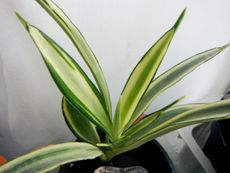 Care Of Kenya Hyacinth: Tips On Growing Flowering Sansevieria
Care Of Kenya Hyacinth: Tips On Growing Flowering SansevieriaKenya hyacinth is a pretty, little succulent that makes a great houseplant. It produces flowers irregularly and can be grown outdoors in hot, dry regions. Care of Kenya hyacinth is not difficult if you provide the right soil and don’t overwater. Learn more here.
By Mary Ellen Ellis
-
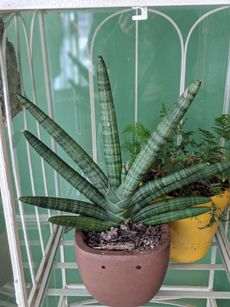 What Is A Starfish Sansevieria: Information About Starfish Sansevieria Care
What Is A Starfish Sansevieria: Information About Starfish Sansevieria CareIf you like succulents, try growing starfish sansevieria. What’s a starfish sansevieria? Starfish sansevieria plants, as their name suggests, are starfish-shaped succulents. The following article contains Sansevieria cylindrica info for growing and their care.
By Amy Grant
-
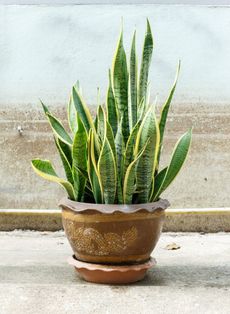 Snake Plant Problems: Leaves Curling On Mother-In-Law’s Tongue
Snake Plant Problems: Leaves Curling On Mother-In-Law’s TongueAlthough the snake plant is very tolerant, it does need some basic care and it can show problems, including curling leaves, if neglected for too long. Find out the causes and what to do for a snake plant with curling leaves in this article.
By Mary Ellen Ellis
-
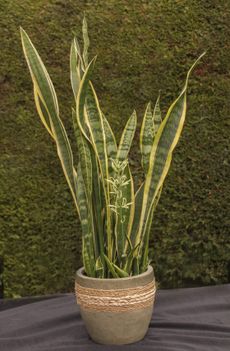 Droopy Snake Plant Leaves – What To Do About A Drooping Mother In Law’s Tongue
Droopy Snake Plant Leaves – What To Do About A Drooping Mother In Law’s TongueYou may know the mother-in-law plant as the snake plant, appropriately nicknamed for its tall, slender, upright leaves. If your snake plant has droopy leaves, it's an indication that something isn't right. Click here for suggestions about possible causes and fixes.
By Mary H. Dyer
-
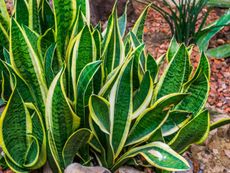 How To Get Rid Of Snake Plants
How To Get Rid Of Snake PlantsThe (usually) popular snake plant, also known as mother-in-law tongue can become invasive. Learn how to cope when this distinctive plant outgrows its boundaries.
By Mary H. Dyer
-
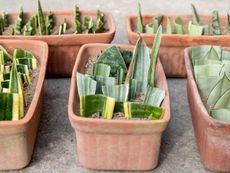 How To Propagate Snake Plants
How To Propagate Snake PlantsTall and stunning, the snake plant can be easily propagated for gifts or houseplant elegance in multiple rooms.
By Bonnie L. Grant
-
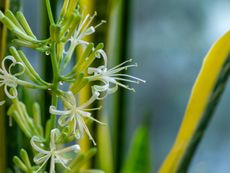 Sansevieria Blooming: Flowers Of A Sansevierias (Mother-In-Law's Tongue)
Sansevieria Blooming: Flowers Of A Sansevierias (Mother-In-Law's Tongue)You can own a mother-in-law's tongue for decades and never know that they produce flowers, then one day, it has produced a flower stalk. Is this possible? Yes, and this article will explain more.
By Heather Rhoades